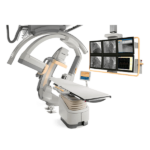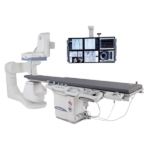A very simple difference between single plane and bi-plane is that single plane has only one C-Arm, whereas Bi-Plane has two C-Arms
A couple of months ago, we wrote a blog post on the differences between floor mounted and ceiling mountedcath lab systems, to help point you in the right direction with your purchase. However, there are plenty of other points to consider when looking at cath lab systems, and besides, how do you know which kind is right for you? Hopefully this post will clear some of those questions up.
Single Plane or Bi-Plane
A very simple difference between single plane and bi-plane is that single plane has only one C-Arm, whereas Bi-Plane has two C-Arms. The two separate C-Arms allow a Bi-Plane to see 3D images in real time, but with a Single Plane it will take a bit longer to capture a 3D image due to the speed of its one C-Arm. Obviously, these differences will factor into price, and Bi-Plane systems are more expensive than their Single Plane counterparts. However, a Bi-Plane is most useful for heart and brain scans, so unless your area of focus is one of the two, you can choose a Single Plane and be just fine. Bi-Plane systems are also much larger than Single Plane, which will make the room requirements for the cath lab much more expansive, including a ceiling that must be able to support a ceiling mounted C-Arm – an added cost upwards of 20K.
Digital Systems or Analog
Digital cath lab systems use a flat panel digital detector, and the quality of the images will be better and rate of deterioration slower than traditional analog cath labs. However, as to be expected, digital systems are much more expensive to purchase and maintain, because replacement parts may be difficult to find. The digital cath lab technology is newer than analog, so this issue makes sense and should be taken into consideration when making your decision.
Get Started
Request Pricing Today!
We’re here to help! Simply fill out the form to tell us a bit about your project. We’ll contact you to set up a conversation so we can discuss how we can best meet your needs. Thank you for considering us!
Great support & services
Save time and energy
Peace of mind
Risk reduction
Image Intensifier Size
There are four different sizes of image intensifiers for you to choose from: 9”, 12”, 15”, and 16”. The smaller image intensifiers have the highest degree of magnification, but the bigger image intensifiers have broader fields of view. Which size you choose also correlates to your specialty: 9” is best for cardiac work, 12” is best for cardiac and angio work, and 15” and 16” are best for angio, vascular, and neurovascular procedures.
Floor Mounted or Ceiling Mounted
As we mentioned above, we wrote a detailed blog post, Floor Mounted Cath Labs vs. Ceiling Mounted, back in June, which will answer questions or concerns you may have about these two types. You can read it HERE.
We hope you’ve gained some insight into which direction to go in with your cath lab purchase. When you’re ready to delve deeper and begin the purchasing journey, Amber Diagnostics’ trusted sales team will be here to answer any questions you may have. Contact us here to get started!


